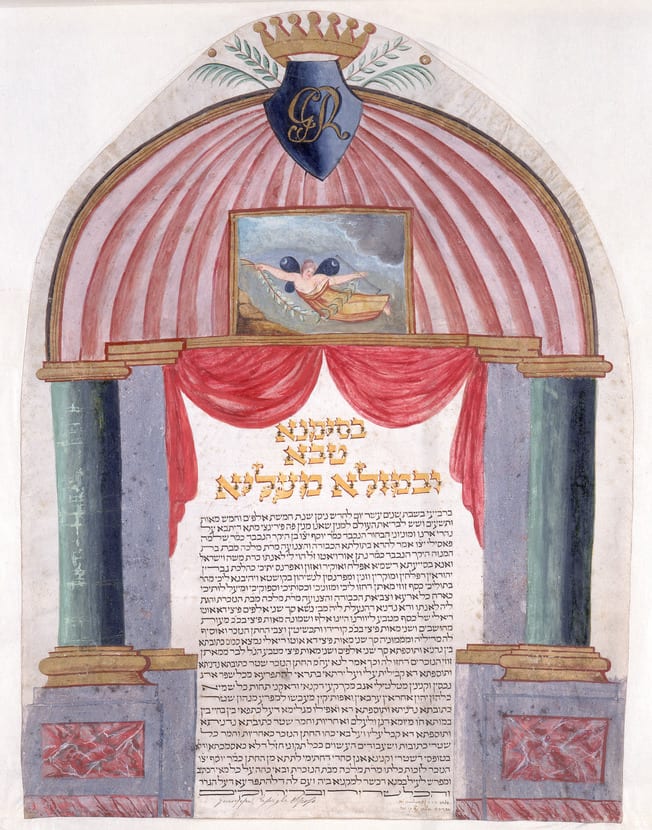
- Object Name:
- Marriage Contract
- Place Made:
- Florence (Italy)
- Date:
- 1836
- Medium:
- Paint, ink, and gold leaf on parchment
- Dimensions:
- 25 1/2 × 19 1/4 in. (64.8 × 48.9 cm)
- Credit Line:
- Gift of Dr. Harry G. Friedman
- Accession Number:
- F 3548
Not On View
Marriage is one of the most important mitzvot, or commandments, in Judaism, and Scriptures are replete with verses encouraging the union of man and woman. One of the essential elements of a Jewish wedding ceremony is the writing and transfer of a marriage contract, or ketubbah (plural, ketubbot). The ketubbah was originally formulated to protect a woman's rights in marriage by establishing the financial obligations of the groom toward his bride in cases of divorce or death. Jews expelled from Spain and Portugal at the end of the 15th century brought the tradition of decorating the ketubbah (marriage contract) to the lands where they settled, including Italy, Holland, England, North Africa, and the Ottoman Empire. The practice flourished in Italy, where there was a long tradition of decorating documents and where reading the ketubbah aloud during the marriage ceremony became popular in the 16th century. The decoration of a ketubbah was not only an embellishment, but was included also for practical reasons. A major concern of Spanish rabbis was that no changes be made to the provisions of the ketubbot after they were signed.
Italian ketubbot stem predominantly from the northern part of the country, with a few examples from central Italy, since Jews had been expelled from other regions before the form became popular. Written in parchment, they usually feature lavish ornamentation, inspired by both Jewish and Christian art. During the 18th century, decorations-ranging from biblical scenes to the signs of the zodiac-became so extravagant that rabbis enacted laws limiting expenditures on marriage contracts. This example, presented within a massive architectural frame, is typical of nineteenth century Florentine illumination, as opposed to seventeenth and eighteenth century ketubbot from that city which have very simple ornamentation or none at all. A crowned shield above is inscribed "GR," initials of the first names of bride and groom, Giuseppe and Regina (Yosef and Malkah in Hebrew). Bearing a trumpet and a laurel branch, the winged figure within a panel is likely a personification of Fama (fame, renown, or rumor).
Italian ketubbot stem predominantly from the northern part of the country, with a few examples from central Italy, since Jews had been expelled from other regions before the form became popular. Written in parchment, they usually feature lavish ornamentation, inspired by both Jewish and Christian art. During the 18th century, decorations-ranging from biblical scenes to the signs of the zodiac-became so extravagant that rabbis enacted laws limiting expenditures on marriage contracts. This example, presented within a massive architectural frame, is typical of nineteenth century Florentine illumination, as opposed to seventeenth and eighteenth century ketubbot from that city which have very simple ornamentation or none at all. A crowned shield above is inscribed "GR," initials of the first names of bride and groom, Giuseppe and Regina (Yosef and Malkah in Hebrew). Bearing a trumpet and a laurel branch, the winged figure within a panel is likely a personification of Fama (fame, renown, or rumor).
Information may change as a result of ongoing research.